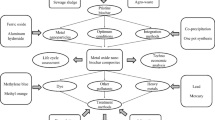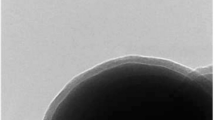Abstract
Natural iron minerals and zero-valent metals have been widely tested as catalysts for the Fenton-like process, but the systematical comparison study about their catalytic performance was rarely conducted, and the risk of the secondary pollution of toxic heavy metals was still not uncertain. In this paper, a comparison study of applying pyrite, ilmenite, vanadium titano-magnetite (VTM), zero-valent iron (ZVI), and zero-valent copper (ZVC) as Fenton-like catalysts for the removal of imidacloprid was performed. The results showed that ZVI exhibited the highest activity among the recyclable solid catalysts with a removal rate of 96.8% at initial pH 3 using 10.78 mmol/L H2O2, due to iron corrosive dissolution. Vanadium titano-magnetite (VTM) exhibited the best activity at first use among tested minerals but with low reusability. Pyrite with stable morphology showed a medium but sustainable ability to degrade imidacloprid, achieving a removal rate of 10.5% in the fifth use. The reaction much favored the acidic condition of initial pH around 2 or 3. Meanwhile, there was a significant positive correlation between removal efficiency and dissolved Fe or Cu concentration. Pyrite was considered to be a promising catalyst in Fenton-like reaction. It was suggested that the system proceeded predominantly through a homogeneous route via dissolved Fe or Cu ions. Except ZVC and VTM, other tested catalysts showed the low possibility of causing secondary pollution of toxic metals in the application of Fenton-like process.











Similar content being viewed by others
Data availability
All data generated or analyzed during this study are included in this published article (and its supplementary information files).
References
Agüera A, Almansa E, Malato S, Maldonado M, Fernández-Alba A (1998) Evaluation of photocatalytic degradation of imidacloprid in industrial water by GC-MS and LC-MS. Analusis 26:245–250. https://doi.org/10.1051/analusis:1998168
Ammar S, Oturan MA, Labiadh L, Guersalli A, Abdelhedi R, Oturan N, Brillas E (2015) Degradation of tyrosol by a novel electro-Fenton process using pyrite as heterogeneous source of iron catalyst. Water Res 74:77–87. https://doi.org/10.1016/j.watres.2015.02.006
Arnold SM, Hickey WJ, Harris RF (1995) Degradation of atrazine by Fenton’s reagent: condition optimization and product quantification. Environ Sci Technol 29:2083–2089. https://doi.org/10.1021/es00008a030
Babuponnusami A, Muthukumar K (2014) A review on Fenton and improvements to the Fenton process for wastewater treatment. J Environ Chem Eng 2:557–572. https://doi.org/10.1016/j.jece.2013.10.011
Barhoumi N, Olvera-Vargas H, Oturan N, Huguenot D, Gadri A, Ammar S, Brillas E, Oturan MA (2017) Kinetics of oxidative degradation/mineralization pathways of the antibiotic tetracycline by the novel heterogeneous electro-Fenton process with solid catalyst chalcopyrite. Appl Catal B 209:637–647. https://doi.org/10.1016/j.apcatb.2017.03.034
Bremner DH, Burgess AE, Houllemare D, Namkung K-C (2006) Phenol degradation using hydroxyl radicals generated from zero-valent iron and hydrogen peroxide. Appl Catal B 63:15–19. https://doi.org/10.1016/j.apcatb.2005.09.005
Brillas E, Sirés I, Oturan MA (2009) Electro-Fenton process and related electrochemical technologies based on Fenton’s reaction chemistry. Chem Rev 109:6570–6631. https://doi.org/10.1021/cr900136g
Che H, Bae S, Lee W (2011) Degradation of trichloroethylene by Fenton reaction in pyrite suspension. J Hazard Mater 185:1355–1361. https://doi.org/10.1016/j.jhazmat.2010.10.055
Chu L, Wang J, Dong J, Liu H, Sun X (2012) Treatment of coking wastewater by an advanced Fenton oxidation process using iron powder and hydrogen peroxide. Chemosphere 86:409–414. https://doi.org/10.1016/j.chemosphere.2011.09.007
Expósito E, Sánchez-Sánchez CM, Montiel V (2007) Mineral iron oxides as iron source in electro-Fenton and photoelectro-Fenton mineralization processes. J Electrochem Soc 154:E116. https://doi.org/10.1149/1.2744134
Fulekar MH (2010) Chemical pesticides. In: Fulekar MH (ed) Environmental biotechnology. CRC Press, Boca Raton, pp 387–404
Halm M-P, Rortais A, Arnold G, Taséi J, Rault S (2006) New risk assessment approach for systemic insecticides: the case of honey bees and imidacloprid (Gaucho). Environ Sci Technol 40:2448–2454. https://doi.org/10.1021/es051392i
Hartmann M, Kullmann S, Keller H (2010) Wastewater treatment with heterogeneous Fenton-type catalysts based on porous materials. J Mater Chem 20:9002–9017. https://doi.org/10.1039/C0JM00577K
He J, Yang X, Men B, Wang D (2016) Interfacial mechanisms of heterogeneous Fenton reactions catalyzed by iron-based materials: a review. J Environ Sci 39:97–109. https://doi.org/10.1016/j.jes.2015.12.003
Hoque ME, Philip OJ (2011) Biotechnological recovery of heavy metals from secondary sources-an overview. Mater Sci Eng C 31:57–66. https://doi.org/10.1016/j.msec.2010.09.019
Huang YH, Zhang TC (2005) Effects of dissolved oxygen on formation of corrosion products and concomitant oxygen and nitrate reduction in zero-valent iron systems with or without aqueous Fe2+. Water Res 39:1751–1760. https://doi.org/10.1016/j.watres.2005.03.002
Kitsiou V, Filippidis N, Mantzavinos D, Poulios I (2009) Heterogeneous and homogeneous photocatalytic degradation of the insecticide imidacloprid in aqueous solutions. Appl Catal B 86:27–35. https://doi.org/10.1016/j.apcatb.2008.07.018
Kuan C, Chang S, Schroeder SLM (2015) Fenton-like oxidation of 4-chlorophenol: homogeneous or heterogeneous? Ind Eng Chem Res 54:8122–8129. https://doi.org/10.1021/acs.iecr.5b02378
Labiadh L, Ammar S, Kamali AR (2019) Oxidation/mineralization of AO7 by electro-Fenton process using chalcopyrite as the heterogeneous source of iron and copper catalysts with enhanced degradation activity and reusability. J Electroanal Chem 853:113532. https://doi.org/10.1016/j.jelechem.2019.113532
Lacson CFZ, de Luna MDG, Dong C, Garcia-Segura S, Lu M-C (2018) Fluidized-bed Fenton treatment of imidacloprid: optimization and degradation pathway. Sustain Environ Res 28:309–314. https://doi.org/10.1016/j.serj.2018.09.001
Lee H-J, Lee H, Lee C (2014) Degradation of diclofenac and carbamazepine by the copper (II)-catalyzed dark and photo-assisted Fenton-like systems. Chem Eng J 245:258–264. https://doi.org/10.1016/j.cej.2014.02.037
Long H, Chun T, Di Z, Wang P, Meng Q, Li J (2016) Preparation of metallic iron powder from pyrite cinder by carbothermic reduction and magnetic separation. Metals 6:88. https://doi.org/10.3390/met6040088
Luo S, Yang S-g, Sun C, Wang X-D (2011) Feasibility of a two-stage reduction/subsequent oxidation for treating Tetrabromobisphenol A in aqueous solutions. Water Res 45:1519–1528. https://doi.org/10.1016/j.watres.2010.10.039
Ma X, Cheng Y, Ge Y, Wu H, Li Q, Gao N, Deng J (2018) Ultrasound-enhanced nanosized zero-valent copper activation of hydrogen peroxide for the degradation of norfloxacin. Ultrason Sonochem 40:763–772. https://doi.org/10.1016/j.ultsonch.2017.08.025
Masomboon N, Ratanatamskul C, Lu M-C (2009) Chemical oxidation of 2, 6-dimethylaniline in the Fenton process. Environ Sci Technol 43:8629–8634. https://doi.org/10.1021/es802274h
Matta R, Hanna K, Chiron S (2007) Fenton-like oxidation of 2, 4, 6-trinitrotoluene using different iron minerals. Sci Total Environ 385:242–251. https://doi.org/10.1016/j.scitotenv.2007.06.030
Navalon S, Alvaro M, Garcia H (2010) Heterogeneous Fenton catalysts based on clays, silicas and zeolites. Appl Catal B 99:1–26. https://doi.org/10.1016/j.apcatb.2010.07.006
Nemeth-Konda L, Füleky G, Morovjan G, Csokan P (2002) Sorption behaviour of acetochlor, atrazine, carbendazim, diazinon, imidacloprid and isoproturon on Hungarian agricultural soil. Chemosphere 48:545–552. https://doi.org/10.1016/s0045-6535(02)00106-6
Neyens E, Baeyens J (2003) A review of classic Fenton’s peroxidation as an advanced oxidation technique. J Hazard Mater 98:33–50. https://doi.org/10.1016/s0304-3894(02)00282-0
Nidheesh P (2015) Heterogeneous Fenton catalysts for the abatement of organic pollutants from aqueous solution: a review. RSC Adv 5:40552–40577. https://doi.org/10.1039/C5RA02023A
Nidheesh P, Gandhimathi R, Velmathi S, Sanjini N (2014) Magnetite as a heterogeneous electro Fenton catalyst for the removal of Rhodamine B from aqueous solution. RSC Adv 4:5698–5708. https://doi.org/10.1039/c3ra46969g
Nidheesh PV, Olvera-Vargas H, Oturan N, Oturan MA (2017) Heterogeneous electro-Fenton process: principles and applications. In: Zhou M, Oturan MA, Sirés I (eds) Electro-Fenton process. Springer, Singapore, pp 85–110
Rezaei F, Vione D (2018) Effect of pH on zero valent iron performance in heterogeneous Fenton and Fenton-like processes: a review. Molecules 23:3127. https://doi.org/10.3390/molecules23123127
Sánchez-Sánchez CM, Expósito E, Casado J, Montiel V (2007) Goethite as a more effective iron dosage source for mineralization of organic pollutants by electro-Fenton process. Electrochem Commun 9:19–24. https://doi.org/10.1016/j.elecom.2006.08.023
Teel AL, Warberg CR, Atkinson DA, Watts RJ (2001) Comparison of mineral and soluble iron Fenton’s catalysts for the treatment of trichloroethylene. Water Res 35:977–984. https://doi.org/10.1016/s0043-1354(00)00332-8
Tišler T, Jemec A, Mozetič B, Trebše P (2009) Hazard identification of imidacloprid to aquatic environment. Chemosphere 76:907–914. https://doi.org/10.1016/j.chemosphere.2009.05.002
Vagı M, Petsas A (2017) Advanced oxidation processes for the removal of pesticides from wastewater: recent review and trends. In: 15th international conference on environmental science and technology. CEST2017, Rhodes, Greece, vol 31
Wamhoff H, Schneider V (1999) Photodegradation of imidacloprid. J Agric Food Chem 47:1730–1734. https://doi.org/10.1021/jf980820j
Wang Y, Zhao H, Chai S, Wang Y, Zhao G, Li D (2013) Electrosorption enhanced electro-Fenton process for efficient mineralization of imidacloprid based on mixed-valence iron oxide composite cathode at neutral pH. Chem Eng J 223:524–535. https://doi.org/10.1016/j.cej.2013.03.016
Wang Y, Zhao H, Li M, Fan J, Zhao G (2014) Magnetic ordered mesoporous copper ferrite as a heterogeneous Fenton catalyst for the degradation of imidacloprid. Appl Catal B 147:534–545. https://doi.org/10.1016/j.apcatb.2013.09.017
Wang N, Zheng T, Zhang G, Wang P (2016) A review on Fenton-like processes for organic wastewater treatment. J Environ Chem Eng 4:762–787. https://doi.org/10.1016/j.jece.2015.12.016
Wen G, Wang S-J, Ma J, Huang T-L, Liu Z-Q, Zhao L, Xu J-L (2014) Oxidative degradation of organic pollutants in aqueous solution using zero valent copper under aerobic atmosphere condition. J Hazard Mater 275:193–199. https://doi.org/10.1016/j.jhazmat.2014.05.002
Xue X, Hanna K, Abdelmoula M, Deng N (2009) Adsorption and oxidation of PCP on the surface of magnetite: kinetic experiments and spectroscopic investigations. Appl Catal B 89:432–440. https://doi.org/10.1016/j.apcatb.2008.12.024
Yuan X, Pham AN, Xing G, Rose AL, Waite TD (2012) Effects of pH, chloride, and bicarbonate on Cu (I) oxidation kinetics at circumneutral pH Environmental. Environ Sci Technol 46:1527–1535. https://doi.org/10.1021/es203394k
Zhang H, Choi HJ, Huang C-P (2005) Optimization of Fenton process for the treatment of landfill leachate. J Hazard Mater 125:166–174. https://doi.org/10.1016/j.jhazmat.2005.05.025
Zhang C, Zhou L, Yang J, Yu X, Jiang Y, Zhou M (2014) Nanoscale zero-valent iron/AC as heterogeneous Fenton catalysts in three-dimensional electrode system. Environ Sci Pollut Res Int 21:8398–8405. https://doi.org/10.1007/s11356-014-2791-1
Zhang Y, Fan J, Yang B, Huang W, Ma L (2017) Copper–catalyzed activation of molecular oxygen for oxidative destruction of acetaminophen: the mechanism and superoxide-mediated cycling of copper species. Chemosphere 166:89–95. https://doi.org/10.1016/j.chemosphere.2016.09.066
Zhou T, Li Y, Ji J, Wong F-S, Lu X (2008) Oxidation of 4-chlorophenol in a heterogeneous zero valent iron/H2O2 Fenton-like system: Kinetic, pathway and effect factors. Sep Purif Technol 62:551–558. https://doi.org/10.1016/j.seppur.2008.03.008
Zhou P, Zhang J, Liu J, Zhang Y, Liang J, Liu Y, Liu B, Zhang W (2016a) Degradation of organic contaminants by activated persulfate using zero valent copper in acidic aqueous conditions. RSC Adv 6:99532–99539. https://doi.org/10.1039/C6RA24431A
Zhou P, Zhang J, Zhang Y, Liang J, Liu Y, Liu B, Zhang W (2016b) Activation of hydrogen peroxide during the corrosion of nanoscale zero valent copper in acidic solution. J Mol Catal A Chem 424:115–120. https://doi.org/10.1016/j.molcata.2016.08.022
Funding
The research was financially supported by the Natural Science Foundation of Jiangxi Province (20202BABL213024), the Scientific Research Fund of Jiangxi Provincial Education Department (GJJ190229), and the Doctoral Research Fund of the Jiangxi Agricultural University (Project No.9232307058).
Author information
Authors and Affiliations
Contributions
Siwan Liu, Wenwei Yu, and Huang Cai conducted the main experiments. Faying Lai and Huajun Huang interpreted the study of leached toxic heavy metals. Hansun Fang did the analysis of imidacloprid degradation mechanism. Jinbao He designed the whole experiment and wrote the manuscript. All authors read and approved the final manuscript.
Corresponding author
Ethics declarations
Ethics approval and consent to participate
Not applicable.
Consent for publication
Not applicable.
Conflict of interest
The authors declare no competing interests.
Additional information
Responsible Editor: Ricardo Torres-Palma
Publisher’s note
Springer Nature remains neutral with regard to jurisdictional claims in published maps and institutional affiliations.
Supplementary information
ESM 1
Chemical structure of imidacloprid; Photograph of natural minerals and zero-valent metals; Characteristics of simulated imidacloprid wastewater; UV-visible spectrum of the prepared wastewater; linear fitting result of the relationship between imidacloprid concentration and the absorbance at 270 nm; UV-visible spectra of the solutions after removing the metallic sludge in alkaline condition; SEM images of fresh and five-times-used ilmenite, VTM, ZVC as well as EDS image and elemental composition of them; textural properties of the studied materials; the concentrations of dissolved Cu and Fe after consecutive reactions at initial pH 3; total ion chromatogram from GC–MS analysis of the ZVI treated sample. (DOCX 10971 kb)
Rights and permissions
About this article
Cite this article
Liu, S., Yu, W., Cai, H. et al. A comparison study of applying natural iron minerals and zero-valent metals as Fenton-like catalysts for the removal of imidacloprid. Environ Sci Pollut Res 28, 42217–42229 (2021). https://doi.org/10.1007/s11356-021-13731-x
Received:
Accepted:
Published:
Issue Date:
DOI: https://doi.org/10.1007/s11356-021-13731-x




